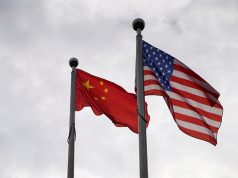The nine-dash line, which is literally composed of dash marks, marking an expansive area of the South China Sea that China claims it has historical jurisdiction over has already been invalidated as baseless by an international tribunal.
Yet over the past week alone, China’s map including dubious marker made appearances on a television program and in a movie.
The new animated film “Abominable” featured the nine-dash claim on a map seen in one of its scenes, screenshots of which were shared on social media.
The movie, which was released in theaters last September, was produced by Shanghai-based Pearl Studio and Dreamworks Animation.
Celebrated director Kip Oebanda was among those who questioned the film creators’ motive for flashing the map in the movie.
“No wonder the map includes the 9-dash line under Chinese territory. This is not just a children’s film. This is Chinese propaganda,” he said.
Abominable is Courtesy of DreamWorks Animation and Pearl Studio in a Hollywood/China co-production.
No wonder the map includes the 9-dash line under Chinese territory. This is not just a children's film. This is Chinese propaganda.
Just go catch Qcinema instead. pic.twitter.com/BEWzNa0aDU
— Kip Oebanda (@kipoebanda) October 14, 2019
He encouraged Filipinos to support the ongoing QCinema International Film Festival which featured independent local and overseas short films instead.
So far, Vietnam is the only country that made the move to ban the movie from being released in the country.
Meanwhile, sports channel ESPN briefly showed China’s old map and included Taiwan on it, suggesting endorsement of the country’s territorial claims, during its morning sports show last October 10.
These instances raised questions on the Asian giant’s intention: Is there a global, subliminal campaign against the arbitral tribunal award favoring the Philippines? Has China’s propaganda already infiltrated mainstream content providers?
A New York-based international law professor who has long been an observer of the maritime tension in the region over China’s South China Sea claims shared that this was his first to see the nine-dash line map outside of China.
Before these sightings, the Chinese government was known to have widely used this controversial material within its borders.
“If this is real, this would be a major blunder. I’ve literally never seen that map outside of China,” Julian Ku said.
If this is real, this would be a major blunder. I’ve literally never seen that map outside of China. https://t.co/ASmsaHqdEm
— Julian Ku 古舉倫 (@julianku) October 10, 2019
The network reportedly used a different map in a succeeding broadcast.
ESPN previously received the brunt of criticisms from China after a now-deleted tweet by Houston Rockets general manager Daryl Morey who previously expressed his support to the anti-China protests in Hong Kong.
The sports channel also forbids its anchors to discuss politics on-air.
The nine-dash line had been legally invalidated by the Permanent Court of Arbitration in The Hague, Netherlands in 2016, in a case brought up by the Philippines. China encroached on the Philippines’ West Philippine Sea by constructing islands and military installations and cutting off access to Filipino fishermen all within Philippine waters.
The tribunal also found China’s activities such as conducting massive land reclamation and stealing of important marine creatures as violation of its commitment under the United Nations Convention on the Law of the Sea.
Insisting against international law
China has been using the nine-dash line as basis to defend its assertion in the South China Sea, thereby sowing dispute with neighboring terriroties with stakes on the waters, namely Taiwan, Vietnam, Malaysia and Brunei.
The line previously comprised 11 dashes and first appeared on a Chinese map in 1947 when the Chinese navy took control of some islands in the South China Sea occupied by Japan.
In the 1950s, two dashes were removed and abandoned its assertion on the Gulf of Tonkin to North Vietnam.
China figured a violent clash against the South Vietnamese navy in the mid-1970s and expelled the latter from the Paracel Islands.
Since the 1980s, it took control of about 200 reefs in the Spratlys Islands and then the Scarborough Shoal in 2012.
The line was not called as such inside China, a Chinese marine geographer told TIME magazine back in 2016.
Wang Ying was a member of the Chinese Academy of Sciences and a “disciple” of Yang Huairen, the Chinese geographer who helped etch the 11-dashed boundary before.
Wang, who expressed disagreement with the 2016 ruling, also recalled that Chinese schoolchildren had been taught that China’s territory reached up to James Shoal, which is in Malaysia’s jurisdiction.
“The dash lines mean the ocean, islands and reefs all belong to China and that China has sovereign rights. But it’s discontinuous, meaning that other countries can pass through the lines freely,” Wang said.










